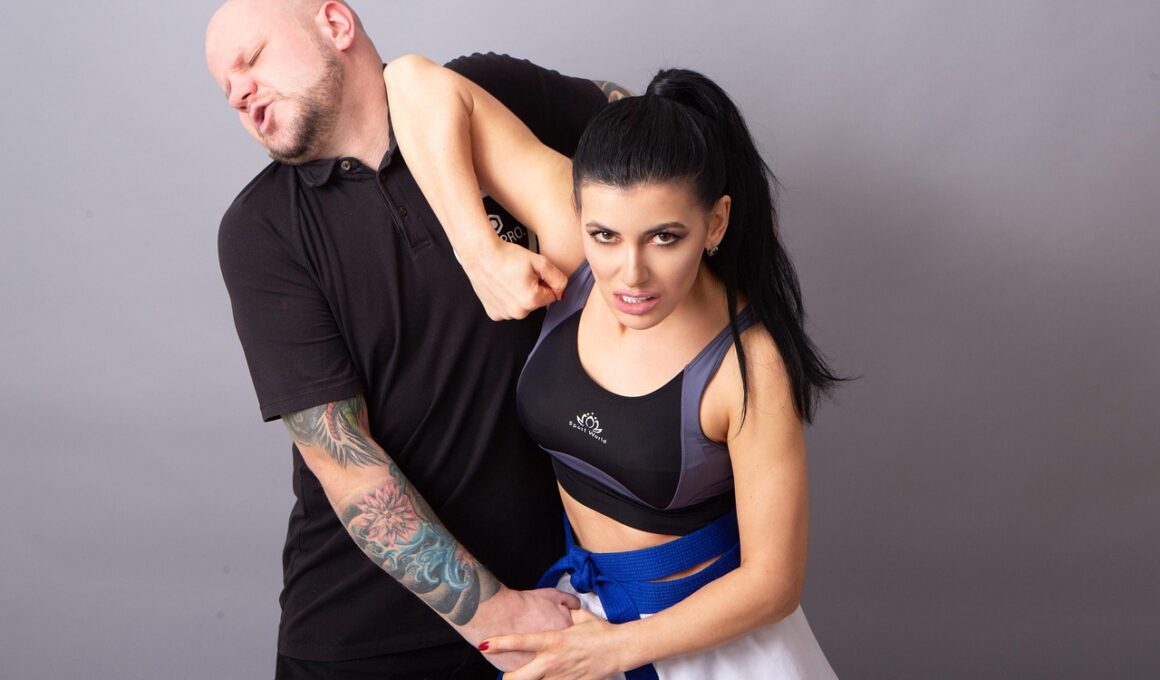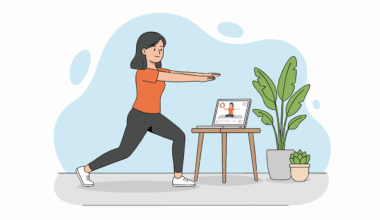Simple Drills to Improve Reaction Time
Improving your reaction time is essential in self-defense situations. Consistent practice can enhance the ability to respond quickly and effectively. Several drills can be incorporated into your training routine, each designed to sharpen your reflexes. One effective method is the use of a partner drill, where one person throws light punches while the other practices defending them. This drill builds not only reflexes but also the ability to read movements. Moreover, focus mitt training allows you to react to both visual and tactile signals. Engaging with focus pads helps hone timing, coordination, and accuracy, essential elements in self-defense. Additionally, shadow boxing can be advantageous, as it reinforces muscle memory and reaction speed. Use a mirror to improve your form as you visualize an opponent in front of you. Including a timer to challenge yourself can intensify these sessions, pushing limits further. Don’t forget the importance of footwork in enhancing overall agility. Regularly switching stances during practice further develops adaptability, an important trait for any self-defender. Remember, safety is crucial during practice, so use proper protective gear and ensure communication in partner drills for effective training without injury.
Another valuable drill to enhance reaction time is incorporating agility exercises. These drills increase physical responsiveness while improving body coordination. Ladder drills, for instance, help develop foot speed and precision, enabling faster movement in self-defense scenarios. Set up an agility ladder and perform various patterns, coordinating your steps at increasing speeds. Another approach is cone drills, valuable for practicing quick direction changes. Set cones around to enhance lateral movement, offering a realistic feel for evading attacks. Furthermore, include reaction balls in your training arsenal. These unique balls bounce unpredictably, forcing you to respond quickly to changing situations. Toss one against a wall and practice catching it, adapting to the unexpected bounces while stimulating your brain to react rapidly. Incorporate reaction-based games into your practice, as they add a fun yet productive element. Use apps and timers that create random cues to help you train your response skills. Building your reaction time takes consistent effort from diverse drills. Always vary your training as this keeps practice engaging while targeting different reflex elements. Remember to keep sessions enjoyable to foster motivation, ensuring you remain committed to continuous improvement in your reaction time.
Punch and Block Reflex Drills
Punch and block reflex drills are particularly instrumental in improving your self-defense skills. Engaging in these specific drills helps not only in enhancing your reflexes but also in melding offense with defense. Partner up and take turns training this way; one partner will attempt to land a punch while the other will react with the appropriate block or evasive maneuver. Incorporating a head guard can keep it safe while allowing for more intense practice. Practicing various punches—hooks, jabs, and crosses—ensures that your reflexes adapt to different fighting techniques. Gradually increase the speed of punches thrown as both partners become more comfortable, which ensures advancement in reaction time without compromising safety. You can even combine different combinations of movements, like circling and striking, which require quick judgment. This variation makes the practice more realistic, mimicking the unpredictability of a real confrontation. Regular practice of punching and blocking will inevitably enhance your muscle memory. However, ensure you’re mindful of technique while executing these drills to prevent developing bad habits, practicing only accurately represents how to react in a real-life encounter or confrontation seamlessly.
In addition to punch and block drills, it’s beneficial to perform slow-motion reaction drills. These involve practicing movements at a relaxed pace, allowing your brain and body to fully comprehend each action. Concentrating on muscle memory during slow motion lets your mind establish a connection to movements before ramping up the tempo. After mastering slow performance, gradually increase speed, ensuring that the fluidity of movements is maintained. This drill is especially useful for keeping calm and controlled in adrenaline-inducing situations. Once comfortable, introduce distracting elements, such as verbal commands, for additional layers of complexity. This trains your ability to handle external pressures, emulating real-life scenarios where distractions may occur. Another option involves sparring with controlled parameters, limiting strikes while focusing on response. Communicate clear expectations with a partner to coordinate effectively, ensuring safety while still pushing limits. Not only do these drills improve reflexes, but they also build your tactical awareness and decision-making skills. Consistent practice of slow-motion techniques, transitioning to speed, offers a high-tech solution for sharpening reaction time while minimizing the risk of injuries or mistakes.
The Role of Visualization Techniques
The role of visualization techniques is often underestimated in self-defense training. Mental imagery can significantly enhance your reaction time and prepare your mind for real-life scenarios. By visualizing various self-defense situations, you train your brain to respond instinctively when faced with actual conflict. This process involves creating mental scenarios where you envision yourself defending against various types of attacks. Utilize this technique before sleep or during quiet moments to rehearse responses and movements. Regular mental training can be just as important as physical drills, reprogramming your responses to be quicker and more fluid. Consider combining visualization with physical training; mentally rehearse as you practice the moves. Doing so reinforces the connection between mind and body, creating a cohesive reaction when performed in real situations. Moreover, adding breathing exercises during visualization can help simulate a calm demeanor when faced with stress. Practicing mindfulness alongside imagery techniques can enhance concentration and clarity. Engage your senses to create an immersive experience, ensuring that you are aware of the sounds, sights, and feelings involved. This dual practice fortifies both mental and physical readiness, equipping you with the tools necessary to navigate confrontations adeptly.
One final effective approach focuses on properly developing hand-eye coordination. Refining this skill is critical in self-defense since the ability to track an opponent’s movements directly influences your reaction abilities. One entertaining way to practice hand-eye coordination is through activities like catching or hitting tennis balls. Set up a wall to bounce the ball against, training your ability to respond quickly to ongoing movement. Use various sizes of balls, like tennis balls, to increase the challenge level. As proficiency builds, consider adding teammate drills that require one partner to dodge while the other aims to catch or tag. This builds situational awareness under duress, ensuring your reactions remain sharp. In addition to ball drills, consider using targets to enhance your aim and focus, using stationary or moving targets will bolster your faculties even further. Traditional elements like dartboard practice provide fun, high-stakes environments to motivate personal improvement. Keep the drills engaging and varied to maintain interest in practice sessions. Incorporating focused routines can make a significant difference in sustaining motivation while mastering essential self-defense skills. This collaborative combination of striking drills and hand-eye exercises will optimize your overall response capabilities.
Establishing a Routine for Improvement
Establishing a routine that encompasses various drills targeting reaction time is vital for personal development in self-defense. Consistency is crucial, so allocate specific days for each drill, enabling focus on technique improvement rather than erratic training. Start with a warm-up, moving through flexibility exercises before engaging in more intense drills. Structure sessions by incorporating different elements, alternating between physical training and mental exercises such as visualization. This interspersing of routines helps reinforce learning and establishes a foundation for evolving success. As you progress, keep track of your improvement with a diary or workout group, fostering accountability while enhancing motivation through shared experiences. Set realistic goals to challenge yourself, like mastering specific drills within particular time frames. Periodically reassess these goals to maintain growth and adapt training routines as necessary. Scheduling rest days is just as critical; maintaining balance prevents burnout while ensuring you continue developing your reaction time. Emphasize the need for adaptation in self-defense, proving flexibility essential for overall success. By creating comprehensive training habits that incorporate all these practices, you ensure unyielding preparation for real-world scenarios while enabling continual self-improvement.
In conclusion, improving reaction time through various drills strengthens self-defense capabilities and enhances the overall fitness experience. By incorporating partner drills and agility exercises, individuals refine their reflexes and overall coordination. Engage in actual sparring while focusing on specific movements and responses allows practitioners to solidify learned techniques effectively. Don’t overlook the importance of visualization and mental exercises, as they work hand-in-hand to prepare individuals for real-world situations. Establishing a proper routine ensures comprehensive development, combining physical conditioning with mental acuity while emphasizing the need for adaptability. Always remember to vary your training to keep up engagement, making consistent practice enjoyable and fulfilling. Finally, share your journey with others to increase motivation, such as joining local self-defense clubs and communities. Connecting with like-minded individuals offers support while pushing you out of your comfort zone. Overall, improving reaction time is not merely a task but a continual commitment requiring dedication, practice, and mindfulness. As you enhance your skills, uncover newfound confidence in ability, ultimately contributing to better personal safety. Empower yourself through ongoing training, leaving you equipped and ready should a self-defense scenario arise in daily life. Stay proactive in your approach to self-defense and personal safety.


